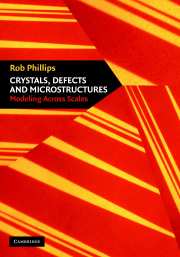
-
Select format
-
- Publisher:
- Cambridge University Press
- Publication date:
- October 2009
- February 2001
- ISBN:
- 9780511606236
- 9780521790055
- 9780521793575
- Dimensions:
- (247 x 174 mm)
- Weight & Pages:
- 1.738kg, 808 Pages
- Dimensions:
- (247 x 174 mm)
- Weight & Pages:
- 1.608kg, 720 Pages
You may already have access via personal or institutional login
Book description
Materials science has emerged as one of the central pillars of the modern physical sciences and engineering, and is now even beginning to claim a role in the biological sciences. A central tenet in the analysis of materials is the structure-property paradigm, which proposes a direct connection between the geometric structures within a material and its properties. The increasing power of high-speed computation has had a major impact on theoretical materials science and has permitted the systematic examination of this connection between structure and properties. In this graduate textbook, Rob Phillips examines the various methods that have been used in the study of crystals, defects and microstructures and that have made such computations possible. A second key theme is the presentation of recent efforts that have been developed to treat problems involving either multiple spatial or temporal scales simultaneously.
Reviews
‘It covers an extremely wide range of topics including good case studies of new systems such as nanotubes. It succeeds in convening modelling ideas from both a physics and materials science point of view. … This book’s distinct feature, which makes it attractive as a general reference book, is the inclusion of a lot of the author’s personal opinions, and makes it stand out from most classroom or course textbooks. To support this, the style of writing is informal, easy to read, and sometimes fun.’
Dr Wei Sha Source: Materials World
‘… a timely and relevant postgraduate level text covering an unusual and exciting new topic …’.
Joan Halfpenny Source: Chemistry in Britain
‘I would recommend it to anyone wishing to get both a broad overview of the intersection of theoretical condensed matter physics with modern materials science, and some good pointers toward future research directions.’
Nigel Goldenfeld Source: Physics Today
Contents
Metrics
Full text views
Full text views help Loading metrics...
Loading metrics...
* Views captured on Cambridge Core between #date#. This data will be updated every 24 hours.
Usage data cannot currently be displayed.
Accessibility standard: Unknown
Why this information is here
This section outlines the accessibility features of this content - including support for screen readers, full keyboard navigation and high-contrast display options. This may not be relevant for you.
Accessibility Information
Accessibility compliance for the PDF of this book is currently unknown and may be updated in the future.


